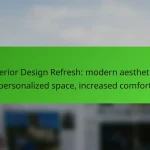An open floor plan transforms living spaces by promoting improved flow and encouraging social interaction among occupants. By eliminating barriers, this design allows for seamless movement and communication, fostering a sense of community. Additionally, abundant natural light enhances the ambiance, making the environment more inviting and conducive to connection.

How does an open floor plan improve social interaction?
An open floor plan enhances social interaction by removing barriers between spaces, allowing for more fluid movement and communication. This design fosters a sense of community and engagement among family members and guests, making it easier to connect and share experiences.
Encourages group activities
Open floor plans create expansive areas that are conducive to group activities, such as cooking, playing games, or hosting gatherings. With fewer walls, people can easily join in on activities without feeling isolated in separate rooms. This setup is ideal for families and friends who enjoy spending quality time together.
For example, a kitchen that opens into a living room allows the cook to interact with guests while preparing meals, making it easier to include everyone in the fun. Consider arranging furniture to facilitate movement and encourage participation in group activities.
Facilitates conversation
By eliminating physical barriers, open floor plans promote easier conversation flow. People can engage in discussions without needing to move from one room to another, which can often interrupt the dialogue. This seamless interaction helps build stronger relationships and enhances overall communication.
To maximize this benefit, consider using furniture arrangements that face each other, creating inviting spaces for conversation. Avoid clutter that may obstruct sightlines and make it harder for people to connect verbally.
Enhances family bonding
An open floor plan significantly enhances family bonding by allowing members to spend time together in a shared space. When family members can see and hear each other easily, they are more likely to engage in meaningful interactions, strengthening their connections.
Incorporate activities that encourage participation from all family members, such as movie nights or collaborative cooking. This shared experience fosters a sense of unity and belonging, making the home a more nurturing environment.

What are the benefits of natural light in open floor plans?
Natural light in open floor plans enhances the living environment by improving aesthetics, increasing energy efficiency, and promoting well-being. It creates a brighter, more inviting space that encourages social interaction and a sense of connection among occupants.
Boosts mood and productivity
Exposure to natural light has been shown to positively influence mood and increase productivity. People working or living in well-lit spaces often report feeling more energized and focused, which can lead to better performance in daily tasks.
To maximize the benefits, consider positioning workspaces near windows or using light-colored furnishings that reflect sunlight. This can create a more uplifting atmosphere, especially in home offices or communal areas.
Reduces energy costs
Utilizing natural light effectively can significantly lower energy costs by reducing the need for artificial lighting during the day. By designing open floor plans with ample windows and skylights, homeowners can take advantage of sunlight to illuminate their spaces.
For optimal energy savings, consider using energy-efficient windows that minimize heat loss in winter and reduce heat gain in summer. This approach not only cuts electricity bills but also contributes to a more sustainable living environment.
Improves indoor air quality
Natural light often accompanies better ventilation, which is crucial for maintaining good indoor air quality. Open floor plans that allow for cross-ventilation can help reduce indoor pollutants and humidity levels, creating a healthier living space.
Incorporating plants into these areas can further enhance air quality, as they absorb carbon dioxide and release oxygen. Choose low-maintenance plants that thrive in bright environments to complement the natural light and improve overall air quality.

How can I design an open floor plan for better flow?
Designing an open floor plan for better flow involves creating a seamless transition between spaces that enhances movement and interaction. Focus on strategic furniture placement, designated activity zones, and suitable materials to achieve a harmonious layout.
Utilize furniture arrangement
Effective furniture arrangement is crucial for promoting flow in an open floor plan. Position larger pieces, like sofas and dining tables, to create natural pathways and avoid obstructing movement. Consider using modular furniture that can be easily rearranged to adapt to different activities or gatherings.
Incorporate multi-functional furniture, such as ottomans with storage or extendable tables, to maximize utility without crowding the space. Avoid excessive furniture that can make the area feel cramped; aim for a balance that encourages social interaction while maintaining openness.
Incorporate zones for activities
Creating distinct zones for various activities enhances the functionality of an open floor plan. Designate areas for cooking, dining, and lounging to provide structure while maintaining an airy feel. Use rugs or lighting to visually separate these zones without the need for walls.
For example, a kitchen island can serve as a cooking zone while also providing seating for casual dining. This not only fosters interaction but also keeps the flow intact, allowing for easy movement between areas.
Choose appropriate materials
Selecting the right materials is essential for achieving a cohesive look and feel in an open floor plan. Opt for flooring that can withstand high traffic, such as hardwood or tile, which also helps to unify different zones. Consider using lighter colors to enhance natural light and create an inviting atmosphere.
In addition, choose furnishings and decor that complement each other in style and color. This consistency fosters a sense of flow and connection throughout the space, making it feel larger and more inviting. Avoid overly heavy or dark materials that may disrupt the open feel.

What are the challenges of open floor plans?
Open floor plans can enhance the flow and social interaction in a space, but they also present several challenges that homeowners should consider. Key issues include noise management, lack of privacy, and temperature control difficulties, which can impact the overall comfort and functionality of the environment.
Noise management issues
One of the primary challenges of open floor plans is managing noise levels. Without walls to absorb sound, conversations, music, and other activities can create a cacophony that disrupts the space. This can be particularly problematic in homes with multiple occupants or during gatherings.
To mitigate noise issues, consider using area rugs, curtains, and soft furnishings that can help absorb sound. Additionally, strategically placing furniture can create natural barriers that reduce noise transmission between different areas.
Lack of privacy
Open floor plans often sacrifice privacy, making it difficult for individuals to find quiet moments or engage in private conversations. This can be a concern for families or roommates who may need personal space throughout the day.
To enhance privacy in an open layout, consider using room dividers or screens that can be moved as needed. Creating designated zones with furniture arrangements can also help establish boundaries while maintaining the open feel of the space.
Temperature control difficulties
Temperature control can be challenging in open floor plans due to the large, unobstructed areas that may not heat or cool evenly. This can lead to hot or cold spots, making it difficult to maintain a comfortable environment throughout the home.
To improve temperature regulation, consider installing zoned heating and cooling systems that allow for targeted climate control in different areas. Using ceiling fans and strategically placed vents can also help distribute air more evenly across the space.

What factors should I consider when transitioning to an open floor plan?
When transitioning to an open floor plan, consider the structural integrity of walls, local building codes, and the overall impact on your living space. These factors will help ensure a safe and functional design that enhances flow and social interaction.
Structural integrity of walls
Assessing the structural integrity of walls is crucial before removing any partitions. Load-bearing walls support the weight of the structure above, and removing them without proper reinforcement can lead to serious safety issues. Consult with a structural engineer to identify which walls can be safely removed or modified.
In some cases, you may need to install beams or columns to redistribute weight. This can involve additional costs, so factor these expenses into your budget. Always prioritize safety and consult professionals to avoid costly mistakes.
Local building codes
Local building codes dictate what modifications can be made to your home, including the removal of walls. These regulations vary by region, so it’s essential to check with your local building authority before starting any renovations. Failing to comply with these codes can result in fines or the need to undo completed work.
Permits may be required for significant changes, which can add time and cost to your project. Ensure you have all necessary approvals in place to avoid delays. Familiarize yourself with local regulations to streamline the transition to an open floor plan effectively.








